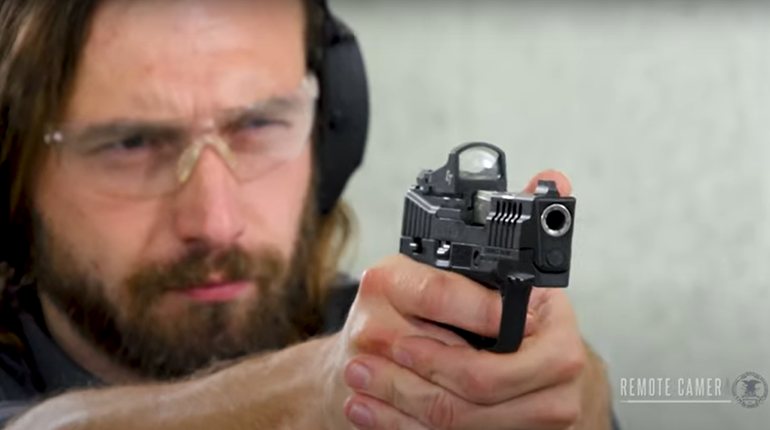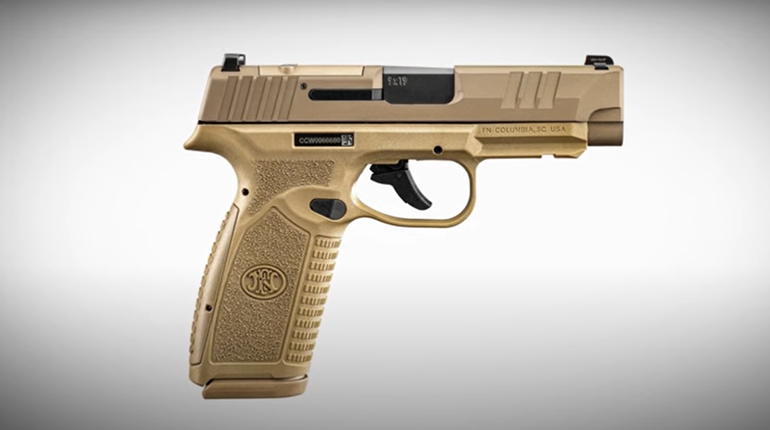
A couple of years ago, I made a tremendous mistake as an editor. I chose to run the then-new Remington R51 on the cover based on a review of a pre-production sample by a trusted writer. My thinking was: “Remington has been around for 200 years, and the company makes iconic rifles and shotguns that are awesome. Therefore, this new handgun—based on an 80-year-old design—must be good. Besides, Remington assured us that the production guns will be the same as the pre-production test model.” I was wrong. The actual initial production run of the R51 was disastrous.
While the handmade samples sent to the many outdoor writers who first saw the pistol worked quite well, Remington simply could not mass produce the design at that time. The guns just did not work, and I justifiably took heat for the decision to run the review.
To repent, I decided to torture test Remington’s next handgun introduction, the RM380. Over the past year, I’ve put more than 1,000 rounds through this diminutive .380 ACP pocket pistol and carried it often. At no point did I clean the gun during the torture-test period, nor did I wear gloves when shooting, so I, too, was tortured; putting 1,000 rounds through a gun this small is not fun. Fortunately, as you will discover, the Huntsville, AL-made, production-line RM380 I tested exhibited nearly perfect reliability and was great to carry in a pocket. But first, some background on the design.
In early 2014, Remington Outdoor Company quietly purchased Rohrbaugh Firearms, a Long Island, NY-based boutique manufacturer of high-quality (and extremely expensive) pocket pistols. Most famous for the recoil-operated R9, chambered in—drum roll—9 mm, the company also had a variant of the R9 that was essentially identical to the 9 mm, but chambered in .380 ACP called the R380. Rohrbaugh’s pistol’s had an excellent reputation for quality amongst the very few people who could afford a pocket pistol that retailed for more than $1,000. A major reason why the guns were so expensive was the company’s lack of economy of scale. Rohrbaugh simply could not manufacture that many guns. Most of the parts used in both the R9 and the R380 were OEM, and therefore had to be purchased prior to assembly. Moreover, as a boutique shop, Rohrbaugh simply lacked the resources of a massive conglomerate like Remington Outdoor Company.

With Rohrbaugh’s design in hand, Remington set out to make the pistol more affordable and also improve the R380’s appeal beyond its price. The resulting pistol was the RM380, which I first had the chance to shoot at Gunsite Academy in late 2014. Unlike the original handgun, the RM380 has an ambidextrous magazine-release button located behind the trigger guard as opposed to a lever at the heel of the grip. This alone is a vast improvement in my opinion, as it makes the tiny pistol’s manual of arms similar to that of larger handguns with which many shooters have more experience. Remington also added a slide-stop lever, which locks the slide back on an empty chamber with the magazine inserted.
Like the Rohrbaugh, the RM380 has a machined, 7075-aluminum frame. This is unusual for most micro .380s on the market, which have polymer frames. While the all-metal construction of the RM380 likely adds cost, it doesn’t add much weight and may be one reason why the pistol was so reliable over the 1,000-plus rounds I put through it.

The metal frame largely follows the Rohrbaugh’s contours, including the undercut trigger guard that allows for a slightly higher grip and more fingers in contact with the frame, which is key on a handgun this small. Remington did, however, extend the beavertail—a welcome change that minimizes the chances of slide-bite.
Operationally, the gun is pretty close to identical to its inspiration. It is a hammer-fired, recoil-operated semi-automatic. The hammer is protected and flush with the slide until the double-action-only trigger is pulled. A brief word on the RM380’s trigger—the only part of the gun I did not like. That’s an understatement; I loathe this trigger. It should not exist. Not only is the pull weight extremely heavy (which I can excuse on a pocket pistol without an external, manual safety), but it is next to impossible to execute a controlled pull. If you attempt to slowly press the trigger to the rear, you will be greeted by increasing resistance until it seems as though a team of war elephants will be needed to break the shot. The RM380 was clearly not meant for slow-fire shooting. That said, once you learn to yank the trigger back, the increasing-resistance problem goes away, and it is nearly impossible to fire the handgun unless you want to. I guess this is OK for a pocket pistol since it is all but impossible to have a negligent discharge with this gun. Still, this trigger is pure evil and I hope Remington fixes it soon, because otherwise the RM380 is a neat little handgun.

Sights are of the low-profile, notch-and-post variety and are machined into the slide, so they cannot be adjusted. For such a small gun that’s designed to be carried in a pocket, the sights are relatively useful. They are small, mind you, but they provide an aiming reference and will not snag when drawing the RM380 from a pocket holster. The pistol is also available with a Crimson Trace Laserguard unit (installed at the factory) for an additional $200, and that is money well-spent. With the laser sight mounted, accurate fire is far easier than relying solely upon the tiny iron sights, and getting a fast, on-target first shot is simple at short ranges.
The slide itself sports useful serrations at the rear to provide purchase when racking. What’s most interesting is the ease with which almost anyone—regardless of hand strength—can operate the RM380’s slide. Thanks to the pistol’s light, dual nested recoil springs, the slide retracts with minimal effort, a huge bonus for anyone who has trouble with a traditional semi-automatic’s slide. Despite the light springs, reliability was darn near perfect, so this is only a positive attribute.
Two, six-round magazines ship with the handgun, one with a flush base and one with a finger extension. I found the latter vastly more comfortable, since it enabled me to put three fingers on the grip as opposed to having my pinky curl beneath the gun with the flush mag. Both magazines consistently dropped free throughout testing.
All right, I’ve hinted at the RM380’s reliability, so here’s the breakdown. In more than 1,000 rounds fired out of the box with no cleaning, I had a grand total of one failure to feed, on round number 90. That was remedied by a quick slap to the magazine’s baseplate, which resulted in the slide pushing the recalcitrant round into the chamber, solving the problem. I suspect the fault in this case was mine, since I encountered no further failures and by round 90 in any session with this tiny handgun, let’s just say one’s hand begins to revolt against one’s brain. I ran lightweight bullets, heavy-for-caliber loads, ball ammo and expanding bullets through the pistol, and it digested everything. Federal HST, PolyCase, SIG Sauer, American Eagle, Liberty Ammunition, DoubleTap, Hornady Critical Defense and other brands were all included, and they all worked just fine.
Other than that single failure to feed out of 1,000-plus rounds, the only other “problem” encountered was three shots where the slide failed to lock back on an empty magazine. These all occurred as the 1,000-round mark was neared, after a year of firing and pocket carry, without cleaning. Furthermore, I don’t view failure to lock back as a major stumbling block, because the gun fired all of the rounds in the magazine without incident—the failure would only result in a slight delay in a reload, not in function.

Such reliability is extremely rare in micro .380 ACP handguns. In fact, I may be one of a very small number of people who have put more than 1,000 rounds through such a pistol, because not only is it somewhat silly to torture oneself in such a manner, it is also an unrealistic amount when we consider what such pistols are designed to be. The RM380 and its competitors are all made for deep concealment, to be drawn in self-defense when all other options are exhausted. Most people might take their little .380s to the range for practice a few times a year, put a few magazines through it and put it back in the pocket holster. These are not plinkers—unless you are a true masochist—nor are they competition guns. Over a lifetime of use, very few people will put 1,000 rounds through any micro .380 ACP, but it’s nice to know that with the RM380, you could.
After torturing the gun and myself in this fashion, I fieldstripped it (which requires a punch to remove what Remington calls the “unlock pin”) and gave it a nice warm bath in a sonic cleaner before testing for accuracy. At 7 yards offhand, it performed as one would expect from a pocket .380 ACP. I again had to disabuse myself of the notion that a slow, controlled trigger pull was even possible, because for all practical purposes, it isn’t. But even with its abomination of a trigger, delivering accurate hits at self-defense distances with the RM380 was not difficult.
With an MSRP of $436, the RM380 is more expensive than some of the more popular .380 ACP pistols on the market. Those handguns, however, have polymer frames and lack some of the RM380’s aesthetic appeal. Also, I don’t know that any such wee pistol exhibits the out-of-the-box reliability of the RM380. While it may be a last-ditch gun best suited only for deep concealment or backup purposes, if you have to go to it, you can be confident that this Remington will go bang when you need it to.






































